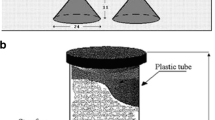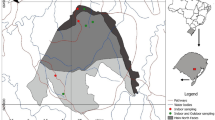Abstract
It is generally accepted that radon emission is strongly influenced by the geological characteristics of the bedrock. However, transport in-soil and entry paths indoors are defined by other factors such as permeability, building and architectural features, ventilation, occupation patterns, etc. The purpose of this paper is to analyze the contribution of each parameter, from natural to man-made, on the radon accumulation indoors and to assess potential patterns, based on 100 case studies in Romania. The study pointed out that the geological foundation can provide a reasonable explanation for the majority of the values recorded in both soil and indoor air. Results also showed that older houses, built with earth-based materials, are highly permeable to soil radon. Energy-efficient houses, on the other hand, have a tendency to disregard the radon potential of the geological foundation, causing a higher predisposition to radon accumulation indoors and decreasing the general indoor air quality.

Similar content being viewed by others
References
Andreescu, I., Codrea, V., Enache, C., Lubenescu, V., Munteanu, T., Petculescu, Al, et al. (2011). Reassessment of the pliocene/pleistocene (neogene/quaternary) boundary in the Dacian Basin (Eastern Peratethys) Romania. Oltenia, Studii şi comunicări, Ştiinţele Naturii, 27(1), 197–220.
Andreescu, I., Codrea, V., Lubenescu, V., Munteanu, T., Petculescu, A., Ştiucă, E., et al. (2013). New developments in the Upper Pliocene–Pleistocene stratigraphic units of the Dacian Basin (Eastern Paratethys), Romania. Quaternary International, 284, 15–29. https://doi.org/10.1016/j.quaint.2012.02.009.
Appleton, J. D. (2007). Radon: Sources, health risks, and hazard mapping. Ambio, 36, 85–90. https://doi.org/10.1579/0044-7447.
Appleton, J. D., & Miles, J. C. H. (2010). A statistical evaluation of the geogenic controls on indoor radon concentrations and radon risk. Journal of Environmental Radioactivity. https://doi.org/10.1016/j.jenvrad.2009.06.002.
Balintoni, I., Balica, C., Cliveti, M., Li, L.-Q., Hann, H. P., Chen, F., et al. (2009). The emplacement age of the Muntele Mare Variscan granite (Apuseni Mountains, Romania). Geologica Carpathica, 60(2009), 495–504. https://doi.org/10.2478/v10096-009-0036-x.
Balintoni, I., Balica, C., Ducea, M. N., & Hann, H. (2014). Peri-Gondwanan terranes in the Romanian Carphatians: A review of their spatial distribution, origin, provenance, and evolution. Geoscience Frontiers. https://doi.org/10.1016/j.gsf.2013.09.002.
Balintoni, I., Mészáros, N., & Györfi, I. (1998). La Transylvanie, dépression et bassins. Studia Universitatis Babeş-Bolyai, Geologia, 43(1), 43–59.
Ball, T., Cameron, D., Coleman, T., & Roberts, P. (1991). Behaviour of radon in the geological environment: A review. Quarterly Journal of Engineering Geology. https://doi.org/10.1144/GSL.QJEG.1991.024.02.01.
Bossew, P. (2015). Mapping the geogenic radon potential and estimation of radon prone areas in Germany. Radiation Emergency Medicine, 4(2), 13–20.
Bossew, P., Dubois, G., & Tollefsen, T. (2008). Investigations on indoor radon in Austria, part 2: Geological classes as categorical external drift for spatial modelling of the radon potential. Journal of Environmental Radioactivity. https://doi.org/10.1016/j.jenvrad.2007.06.013.
Brânzilă, M. (1999). Geologia părtii sudice a Câmpiei Moldovei. In Corson (Ed.), Iaşi.
Burghele, B., Ţenter, A., Cucoş, A., Dicu, T., Moldovan, M., Papp, B., et al. (2019). The FIRST large-scale mapping of radon concentration in soil gas and water in Romania. Science of the Total Environment. https://doi.org/10.1016/j.scitotenv.2019.02.342.
Ciotoli, G., Voltaggio, M., Tuccimei, P., Soligo, M., Pasculli, A., Beaubien, S. E., et al. (2017). Geographically weighted regression and geostatistical techniques to construct the geogenic radon potential map of the Lazio region: A methodological proposal for the European Atlas of Natural Radiation. Journal of Environmental Radioactivity. https://doi.org/10.1016/j.jenvrad.2016.05.010.
Ciupangea, D., Paucă, M., & Ichim, T. (1970). Geologia Depresiunii Transilvaniei. Bucureşti: Academiei R.S.R.
Codarcea, A., Drăgulescu, A., Hinculov, L., Mihăilă, N., Nica, E. (1968). Geological map of Romania. Geological Institute of Romania, 1:200000, sheet L-34-XXII, Timişoara.
Cosma, C., Cucoş, A., Papp, B., Begy, R., Dicu, T., Moldovan, M., et al. (2013). Radon measurements and radon remediation in Bǎiţa-Ştei prone area. Carpathian Journal of Earth and Environmental Sciences, 8(2), 191–199.
Cosma, C., & Jurcuţ, T. (1996). Radonul şi mediul înconjurător. Cluj-Napoca: Dacia.
Cucoş Dinu, A., Cosma, C., Dicu, T., Begy, R., Moldovan, M., Papp, B., et al. (2012). Thorough investigations on indoor radon in Baita radon-prone area (Romania). Science of the Total Environment, 431, 78–83. https://doi.org/10.1016/j.scitotenv.2012.05.013.
Darby, S., Hill, D., Auvinen, A., Barros-Dios, J. M., Baysson, H., & Bochicchio, F. (2005). Radon in homes and risk of lung cancer: collaborative analysis of individual data from 13 European case-control studies. British Medical Journal. https://doi.org/10.1136/bmj.38308.477650.63.
Demoury, C., Ielsch, G., Hemon, D., Laurent, O., Laurier, D., & Clavel, J. (2013). A statistical evaluation of the influence of housing characteristics and geogenic radon potential on indoor radon concentration in France. Journal of Environmental Radioactivity. https://doi.org/10.1016/j.jenvrad.2013.08.006.
Drolet, J.-P., Martel, R., Poulin, P., Dessau, J.-C., Lavoie, D., Parent, M., et al. (2013). An approach to define potential radon emission level maps using indoor radon concentration measurements and radiogeochemical data positive proportion relationships. Journal of Environmental Radioactivity. https://doi.org/10.1016/j.jenvrad.2013.04.006.
EC RP 112 (1999). European Commission, Radiation protection 112, Radiological Protection Principles concerning the Natural Radioactivity of Building Materials, Directorate-General Environment, Nuclear Safety and Civil Protection, EC Luxembourg.
Filipescu, S. (1999). The significance of foraminifera fauna from the Feleac Formation (Transylvanian Basin, Romania). Studia Universitas Babeş-Bolyai, Geologia, 44(2), 125–131.
Filipescu, S. (2011). Cenozoic lithostratigraphic units in Transylvania. In I. Bucur & E. Săsăran (Eds.), Calcareous algae from Romanian Carpathians. Field trip Guidebook (pp. 37–48). Presa: Universitară Clujeană.
Gheorghian, M., & Gheorghian, D. (1994). Datation biostratigraphiques des formations Miocenes du sud de la Transilvanie a partir des foraminiferes. Miocene From Transylvanian Basin, Romania, Cluj-Napoca, 4, 125–134.
Gheorghian, D., Lubenescu, V., & Olteanu, R. (1970). Contribuţii la stratigrafia Miocenului din sudul Transilvaniei. D.S.S. Com Geologic Bucureşti, 57(4), 55–56.
Ghiurcă, V. (1966). Briozoarele tortoniene de la Tălmacel si Cisnădioara-Sibiu. Studia Universitas Babes-Bolyai, Geologia-Geographia, 1, 99–104.
Gundersen, L.C.S., Schumann. R.R., Otton, J.K., Dubiel, R.F., Owen, D.E., Dickinson, K.A. (1992). Geology of radon in the United States. In A.E. Gates and L.C.S. Gundersen (Ed.), Geologic controls on Radon, Boulder, Colorado, Geological Society of America. Special Paper 271.
Ionesi, L. (1994). Geologia unităţilor de platformă si a orogenului nord-dobrogean. Bucureşti: Tehnică.
Kemski, J., Klingel, R., Siehl, A., & Valdivia-Manchego, M. (2009). From radon hazard to risk prediction-based on geological maps, soil gas and indoor measurements in Germany. Environmental Geology. https://doi.org/10.1007/s00254-008-1226-z.
Kemski, J., Klingel, R., Stegemann, A., & Siehl, R. (2005). Radon transfers from ground to houses and prediction of indoor radon in Germany based on geological information. Radioactivity in the Environment. https://doi.org/10.1016/S1569-4860(04)07103-7.
Kemski, J., Siehl, A., Stegemann, R., & Valdivia-Manchego, M. (2001). Mapping the geogenic radon potential in Germany. Science of the Total Environment. https://doi.org/10.1016/S0048-9697(01)00696-9.
Krewski, D., Lubin, J. H., Zielinski, J. M., Alavanja, M., Catalan, V. S., Field, R. W., et al. (2005). Residential radon and risk of lung cancer: a combined analysis of 7 North American case-control studies. Epidemiology, 16(2), 137–145.
Liteanu, E. (1952). Geologia zonei oraşului Bucureşti. Comitetul Geologic Inst Bucureşti, 1, 3–80.
Liteanu, E. (1953). Geologia Ţinutului de câmpie din bazinul inferior al Argeşului si a teraselor Dunării. Inst. Geol., St. tehn. Econ., E/2 Bucuresti, 5–78.
Liteanu, E. (1956). Geologia si hidrogeologia ţinutului dunărean dintre Argeş si Ialomiţa. Bucureşti.
Lubenescu, V. (1981). Studiul biostratigrafic al Neogenului superior din sud-vestul Transilvaniei. Anuarul Institutului de Geologie şi Geofizică, 58, 123–202.
Lupulescu, A., Dicu, T., Papp, B., & Cucoş, A. (2018). Determination of the monthly variation of radon activity concentration in soil. Studia Universitas Babes-Bolyai, Ambientum. https://doi.org/10.24193/subbambientum.2018.1.05.
Mészáros, N., & Clichici, O. (1976). Pe poteci cu banuţei de piatră. Ghid geologic al zonei Cluj. Bucuresti: Sport-Turism.
Mészáros, N., & Clichici, O. (1988). La geologie du Municipe Cluj-Napoca. Studia Universitas Babes-Bolyai, Geologia-Geographia, 33(1), 51–56.
Mészáros, N., Ianoliu, C. (1989). Nannoplankton zones in the Oligocene deposits of the northwesternTransylvanian Basin. The Oligocene from the Transylvanian Basin, Romania. Special volume, “Babeş - Bolyai” University, 157–162. Cluj-Napoca.
Mircescu, V. (1982). Zăcămintele de ape geotermale din Câmpia de Vest, in Schimbul de experienţă: Utilizarea apelor geotermale, Eds. Consiliul Popular al Judetului Timiş, Institutul de proiectari Timişoara, Com. Sin. Com. Ing. Techn., (2), 36-50.
Muntean, L. E., Cosma, C., Cucos (Dinu), A., Dicu, T., & Moldovan, D. V. (2014). Assessment of annual and seasonal variation of indoor radon levels in dwelling houses from Alba county, Romania. Romanian Journal of Physics, 59(1–2), 163–171.
Mutihac, V. (1990). Structura geologică a teritoriului României. Bucureşti: Tehnică.
Nazaroff, W. W. (1992). Radon transport from soil to air. Reviews of Geophysics, 30(2), 137–160.
Neznal, M., & Neznal, M. (2005). Permeability as an important parameter for radon risk classification of foundation soils. Annals of Geophysics. https://doi.org/10.4401/ag-3192.
Neznal, M., Neznal, N., Matolín, M., Barnet, I., & Miksova, J. (2004). The new method for assessing the radon risk of building sites. Prague: Czech Geological Survey.
Otton, J. K. (1991). Potential for indoor radon hazards-A first geologic estimate, In Doe, B.R., (Ed.), Proceedings of a U.S. Geological Survey Workshop on Environmental Geochemistry, U.S. Geological Survey Circular, 1033, pp. 171–173.
Polonic, G. (1985). Neotectonic activity at the eastern border of the Pannonian depression and its seismic implications. Tectonophysics, 47, 109–115.
Răileanu, G., & Saulea, E. (1955). Contribuţii la orizontarea şi cunoaşterea variaţiilor de facies ale paleogenului din regiunea Cluj şi Jibou (NV bazinului Transilvaniei). Revista Universităţii CI Parhon şi a Politehnicii Bucureşti, 8, 233–245.
Răileanu, G., & Saulea, E. (1956). Paleogenul din regiunea Cluj şi Jibou (NV bazinului Transilvaniei). Anuarul Institutului Geologic al României, 29, 272–308.
Răileanu, V., Tătaru, D., Grecu, B., & Bala, A. (2012). Crustal models in Romania-II. Moldavian Platform and adjacent Areas. Romanian Journal of Physics, 57, 1438–1454.
Romanian Energy Performance Methodology, 2006. Metodologie de calcul al performanţei energetice a clădirilor. https://www.mdrap.ro/userfiles/reglementari/Domeniul_XXVII/27_11_MC_001_1_2_3_2006.pdf.
Sachs, H. M., Hernandez, T. L., & Ring, J. W. (1982). Regional geology and radon variability in buildings. Environment International. https://doi.org/10.1016/0160-4120(82)90016-2.
Simionescu, T., Codrea, V., & Trelea, N. (1989). La faune quaternaire de Lovrin (dép. Timis)-Banat. Analele Ştiinţifice ale Universităţii “Al. I. Cuza” Iasi (serie nouă). Geologie-Geografie, 35, 41–53.
Stoici, S., Tătaru, S. (1988). Uraniul si Thoriul. Seria substante minerale utile. In Tehnică (Ed.), Bucureşti.
Tunyagi, A., Dicu, T., Cucoş, A., Burghele, B., Dobrei, G., Lupulescu, A., Moldovan, M., Niţă, D., Papp, B., Zsacsvai, K., Ţenter, A., Beldean-Galea, M.S., Anton, M., Grecu, Ş., Cioloca, L., Miloş, R., Botoş, M.L., Chiorean, C.G., Catalina, T., Istrate, M.A., & Sainz, C. An innovative system for monitoring radon and indoor air quality. Romanian Journal of Physics, 2019 (Accepted).
United Nations Scientific Committee on the Effects of Atomic Radiation (UNSCEAR). (2000). Sources and Effects of Ionizing Radiation, Report to the General Assembly (pp. 1–10). New York: United Nations.
Vancea, A., & Ungureanu, L. (1960). Asupra corelării depozitelor miopliocene din bazinul Transilvaniei pe baza de microfauna. Stud. si cerc. de geolog. Bucureşti, 4, 619–625.
WHO (2009). World Health Organization. Handbook on Indoor Radon, a Public Health Perspective. In Zeeb, Hajo, Shannoun, Ferid (Eds.), p. 110.
Acknowledgements
The research is supported by the project ID P_37_229, Contract No. 22/01.09.2016, with the title “Smart Systems for Public Safety through Control and Mitigation of Residential Radon linked with Energy Efficiency Optimization of Buildings in Romanian Major Urban Agglomerations SMART-RAD-EN” of the POC 2014-2020 Program.
Author information
Authors and Affiliations
Corresponding author
Additional information
Publisher's Note
Springer Nature remains neutral with regard to jurisdictional claims in published maps and institutional affiliations.
Rights and permissions
About this article
Cite this article
Florică, Ş., Burghele, BD., Bican-Brişan, N. et al. The path from geology to indoor radon. Environ Geochem Health 42, 2655–2665 (2020). https://doi.org/10.1007/s10653-019-00496-z
Received:
Accepted:
Published:
Issue Date:
DOI: https://doi.org/10.1007/s10653-019-00496-z




